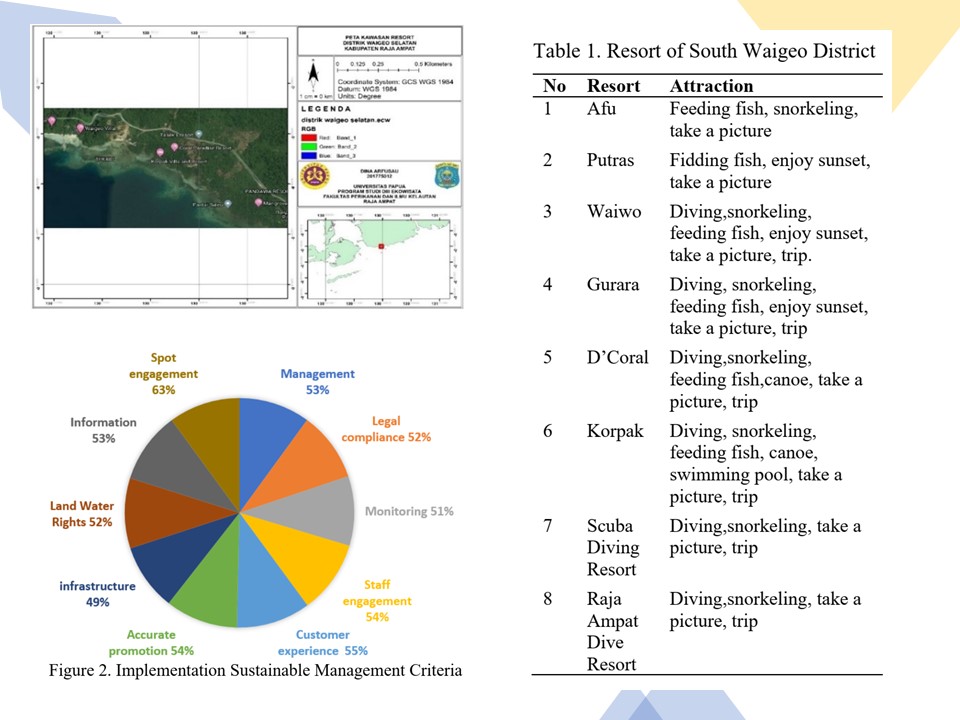Sustainable Marine Tourism of Eco Resort Criteria South Waigeo Raja Ampat Islands
DOI:
https://doi.org/10.46252/jsai-fpik-unipa.2023.Vol.7.No.3.317Keywords:
Eco Resort, marine tourism, Raja AmpatAbstract
Raja Ampat is one of the regions in Indonesia that implements the concept of sustainable marine tourism. The concept of sustainability for eco-resorts is adapted from the criteria of the Global Code of Ethics for Tourism (GSTC). The aim of this study is to find accurate data related to whether 8 resorts in South Waigeo have met the criteria for sustainable accommodation. Research is carried out with the collection of data quantitatively and qualitatively with descriptive analysis. The scores obtained are then processed on a likert scale with P=(F/Nx100%). The total sample was 96 people with a random sampling technique. The results showed GSTC criteria in 8 resorts obtained with a variable percentage. The lowest percentage is in the environmental sustainability criteria of 20-50% including indicators of nature conservation, natural resource management, waste and emission management, criteria for socio-economic improvement of local communities and criteria on the protection of cultural heritage indicate percentages below 55%, while organizational management criteria that include organizational structure, stakeholder engagement, obtain a percentagen of 49-63%. This percentage indicates that eight resorts do not meet the implementation of the criteria of sustainable water tourism, need seriousness together with all stakeholders in encouraging the tourism business to carry out the practice of Sustainable Tourism.
Downloads
References
Amirin, T. (2011). Populasi Dan Sampel Penelitian 4: Ukuran Sampel Rumus Slovin, Erlangga, Jakarta.
Anggita, D., Wardhani, A., & Danusastro, D. (2016). Penilaian Aspek Green Hotel Kelas Menengah. Hotel bIntang 1, 2 dan 3. Modul, Vol 16 No 1 Januari Juni 2016.
Arida, I.N.S. (2023). Pariwisata Berkelanjutan. Sustain-Press Uni-versitas Udayana.
Badan Pusat Statistik (BPS) Kabupaten Raja Ampat. (2021). Kabupaten Raja Ampat Dalam Angka. Realese Book. Raja Ampat
Darmaputra, P.G.R,. Dianasari, D.A.L., & Kalpikawati, I.A. (2020). Penera-pan Konsep Green Hotel di Nusa Lembongan Bali. Jurnal Bisnis Hospitaliti. Vo 9-2 Desember 2020.
Hamimah, T., Huda, N.N., Kamlun, K.U., Rashid, R.A.R., Chan., & Lian, K.J. (2021). Sustainability assessment of mangrove forest as a tourist destination: A case study using GSTC Criteria in Kota Belud, Sabah, Malaysia. IOP Publishing. Tropical Forestry 2021
Hatibie, I.K., Dai, S.L & Legalo, A.M.S. (2020). Kajian Penggunaan Kriteria dan Indikator GSTC Sebagai Instrumen Penilaian Pembangunan Pariwisata Berkenlanjutan Berbasis Lingkungan. Tulisan Ilmiah Pari-wisata. Vol. 3, No. 2 Desember 2020
Kemenparenkraf. (2012). Peraturan Menteri Pariwisata dan Ekonomi Kreatif Nomor PM.35/UM.001/ MPEK/2012 tentang Rencana Stra-tegis Kementerian Pariwisata dan Ekonomi Kreatif Tahun 2012 – 2014.
Koroy, K., Yulianda F., & Butet N. A. (2017). Pengembangan Ekowisata Bahari Berbasis Sumberdaya Pulau Pulau Kecil di Pulau Sayafi dan Liwo Kabupaten Halmahera Tengah. Jurnal Teknologi Perika-nan dan Kelautan IPB Vol. 8 No. 1 Mei 2017.
Kurniawati, E. (2015). Persepsi pengunjung Terhadap Objek Wisata Lubang Tambang Mbah Soero di Kota Sawahlunto Suma-tera Barat. Jurnal Jom FISIP, 2(1), 1–14.
Mardijono. (2008). Persepsi dan Partisispasi Nelayan Terhadap Pengelolaan Kawasan Konservasi Laut Kota Batam [tesis]. Program Pasca Sarjana. Manajemen Sum-berdaya Pantai. Universitas Dipo-negoro. Semarang (ID).
Marsaoly, M. F., Bato, M., & Widiastuti, N. (2017). Economic Benefit of Whale Shark Tourism in Akudiomi Village, District Yaur, Nabire Regency. Jurnal Sumberdaya Akuatik Indopasifik, 1(1), 105–118. https://doi.org/10.30862/jsai-fpik-unipa.2017.Vol.1.No.1.25
Sloan, Philp. (2009). Sustainability in the Hospitality Industry: Principles of Sustainable Operations. Butter-worth-Heinemann/Elsevier
Sugiyono. (2016). Metode Penelitian Kualitatif Kuantitatif dan R&D. Alfabeta.
Rahmafitria. (2014). Eco-Resort dan Green Hotel di Indonesia : Model Sarana Akomodasi yang Berke-lanjutan. Jurnal Manajemen Resort & Leisure. Vol. 11, No. 2, Oktober 2014
Tampubolon, N., Marampa, M. M., & Bato, M. (2021). Evaluation of the Implementation of the Ecotourism Concept in Arborek Village, Raja Ampat. Jurnal Sumberdaya Akuatik Indopasifik, 5(3), 253–262. https://doi.org/10.46252/jsai-fpik-unipa.2021.Vol.5.No.3.163
Tanati, E., Wahyudi, W., & Sinery, A. S. (2020). Participation Levels of Local Community for Ecotourism Management at Saporkren Village South Waigeo Raja Ampat District. Jurnal Sumberdaya Akuatik Indopasifik, 4(2), 193–202. https://doi.org/10.46252/jsai-fpik-unipa.2020.Vol.4.No.2.118
Thahir, M. T., & Lagoa, Y. (2018). Analysis of Seawater Pollution Index Based on Cu and Pb Parameter in Tourism Area of Raja Ampat West Papua. Jurnal Sumberdaya Akuatik Indopasifik, 2(2), 113–118.
https://doi.org/10.30862/jsai-fpik-unipa.2018.Vol.2.No.2.53
Tebay, S., Kaber, Y., Angin, E. P., Manangkalangi, E., Manuputty, A., & Rumayomi, M. R. (2021). Relationship between Perception and Socio-Economic Characte-ristics of Culture Community in the Development of Marine Ecoto-urism in Nusmapi Island. Jurnal Sumberdaya Akuatik Indopasifik, 5(4), 373–386. https://doi.org/10.46252/jsai-fpik-unipa.2021.Vol.5.No.4.181

Downloads
Published
How to Cite
Issue
Section
License
Copyright (c) 2023 Anastasia Gustiarini, Novelina Tampubolon, Novelin Saranga, Djumiati Mustiah, Kurniawan Kurniawan

This work is licensed under a Creative Commons Attribution-ShareAlike 4.0 International License.


















